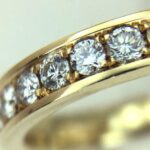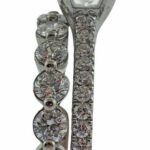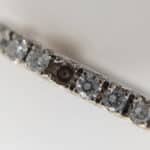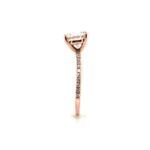“You know what they say about small diamonds? Small tips!”

Today’s bride looking for ever thinner rings set with diamonds has created a demand for new looks. Diamonds less than 1mm in diameter are being set in micro-claw settings. Not only are the diamonds small but the gold holding these diamonds onto the ring is small and thin. With this type of construction, it is inevitable that a diamond or two will be knocked out of the ring. Sometimes seemingly minor knocks bend back the fine claws and ‘poof’ a diamond disappears.
It just isn’t realistic to tell customers that their fine diamond set bands are going to take any type of wear with no consequence. Now not all setting styles are equal. Pave or bead set (figure 1) small diamonds have far better wearability, assuming they are set correctly. The problem with these styles is that they need more gold on the border (they don’t look as thin) and currently, this style is not as popular.

I like all my diamonds set with four claws per diamond (figure 2). This means that there is often a very small gap between each diamond. If there is no gap the diamonds overlap or what is referred to as ‘shingled”, just like shingles on a roof. This is not a desirable technique. If a diamond is hit and pushes against the neighboring diamond it will chip or break one of the two or sometimes both gemstones. While the gap may be hard to see, it is there and the four claws means a bit more metal will show. Less metal showing will make for a thinner look at the expense of durability.

Some settings use a shared claw arrangement. This means that two adjacent diamond are held in place by two claws (figure 3). Each diamond will be held by two claws that are diagonally positioned across from each other. That makes for even finer amounts of gold holding the diamonds on your ring. This arrangement adds a great deal of complexity if the ring has numerous diamonds and needs to be sized smaller.

There is yet another popular setting that is a form of shared claw but has one central claw holding down two diamonds (figure 4 & 5). In this style the gemstone or diamond has exposed edges and with regular wear, results in the edge of the gem, pushed and leveraged. The result is that this style often needs to have the gems tightened. And a personal opinion here; while the design is nice, this is my least favorite due to all the added maintenance needed to tighten the diamonds.


“How could my diamond fall out when I work in an office and don’t do any kind of stressful activity?” Nobody I know wants to make a ring where the diamonds will fall out. Troy Shoppe Jewellers warrantees against loss of small diamonds for two years. Any diamonds falling out just means more work for me and hassle for the client. I was told by an old-timer in the jewellery business decades ago that the best warrantee is the one the store never has to fulfill. In other words, build a ring that won’t have diamonds fall out! With the new styles so sought after, that just isn’t possible.
It may be years before a tip gets knocked back, or maybe months. It is a matter of how the ring is worn. It could be the angle of a sudden knock against a filing cabinet or exit paddle on a door. The ring twisted a bit and a side with diamonds is hit. The impact knocks the small prong back and suddenly, there is a hole on the side of your ring, where there once was a diamond.
Another common occurrence is the small diamond at the end of the ring falling out. This seems to happen more frequently than other diamonds. There are a few reasons:
- The end diamond is typically where the metal of the ring starts to get thinner as the ring moves under the hand. This is partly done for comfort and partly to save the expense of extra metal. As a result, the end claws are more exposed and can be pushed aside.
- Almost everyone that wears a ring will notice their ring sometimes rotates. It may not be a lot, but it happens. When it does, the end diamond that may have been between your fingers is now on the very bottom of your finger. You grab something like a door handle, a gardening tool or a hundred other objects and your small end diamond or the prongs holding it in are slammed. An hour later, you notice the diamond is missing.

Let’s be honest…not all rings are well made. A very common problem, I have seen is when the claws are off center. This is a manufacturing flaw and can be very hard to see for the untrained eye. Simply, what happens here the diamonds are set slightly closer to one edge than the other. That makes one side of prongs weaker than the other. Repair of this flaw is very expensive and, in many cases, just not possible at all requiring that the ring be remade.
Another big problem is when an engagement ring and wedding band are worn together and rub against each other (figure 8). The metal will eventually wear down. If the rings have small prongs that are slightly protruding on the sides, these rub against each other and are just like sandpaper eventually wearing away the metal along the side of the ring. If that metal happens to be small claws, diamonds are no longer being held in place and start falling out. This can lead to an expensive repair. A simple solution, and yes, not every lady likes this option, is to solder the engagement ring and wedding band together. Just in case you didn’t know, this process is reversible.

Another option that works, though not perfect, is to make a thin band to go between the two rings like a washer. If the washer is simple and either smooth or made to fit any indentations in the other rings, it will wear down, but slower and likely prevent a lot of excess wear on the side of the ring that has small, exposed diamond prongs. With the design that is shown (figure 9) with a single shared prong, rubbing against another ring is a huge problem causing the diamonds to come loose.

Troy Shoppe Jewellers understands nobody buys a ring to leave it in the jewelry box it came in. People want to wear their rings. I have found over my years in business (I hate when I sound like an old-timer, but 40 years is a long time!), that a reasonable rate of loss of small diamonds is about 1-2%, within a two-year period. Even with these new styles, the rate of loss has not changed. If anything, clients’ expectations have changed. When a client spends hard earned money, they want some security. I agree. That is why my warrantee is so lenient. I simply replace these little diamonds and go over the situation with the client.
And here is where I get to insert a pet peeve. Look you read this far! When you buy a ring online that is built with small prongs and a thin band, it is easy to offer slightly better prices, because the online sources know that they won’t ever have to warrantee the issues. They may offer a warrantee, but do you want to send your ring to some source in a different province or county to risk losing it with the shipper?
And my last unabashed plug. Troy Shoppe Jewellers will repair jewellery from other sources.